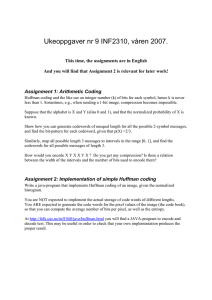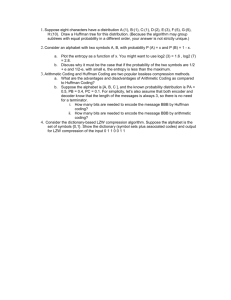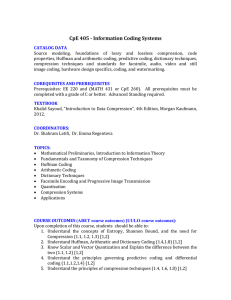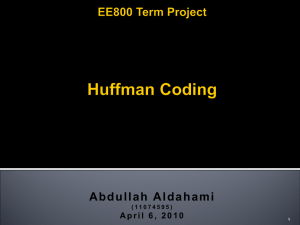International Journal of Application or Innovation in Engineering & Management... Web Site: www.ijaiem.org Email: , Volume 2, Issue 12, December 2013
advertisement
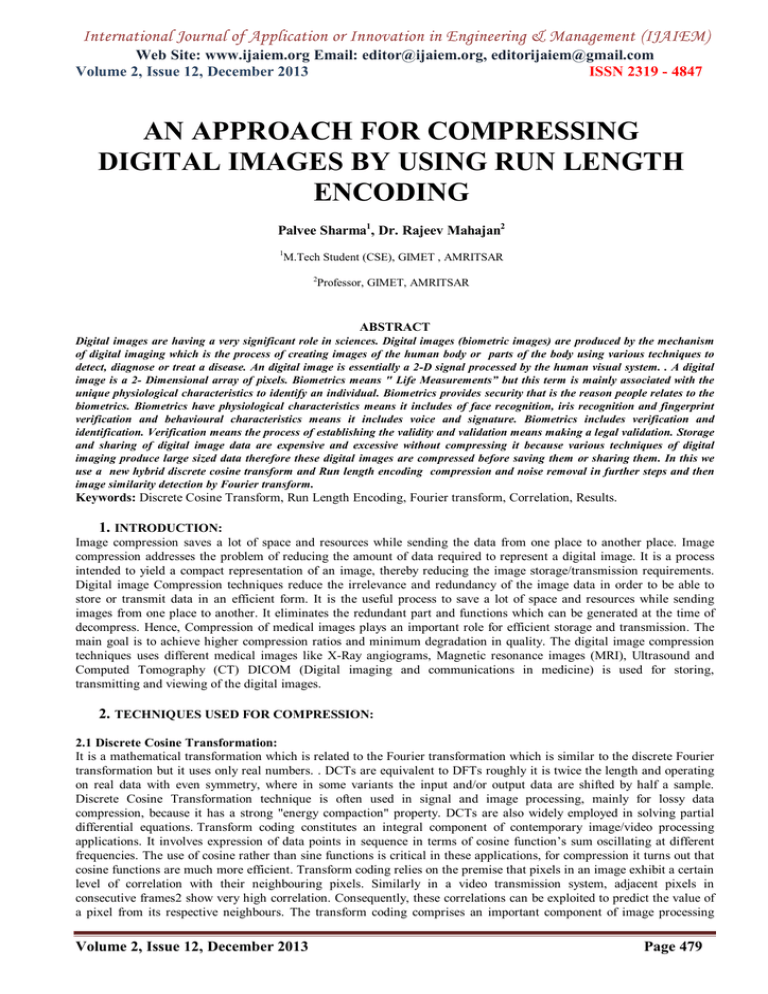
International Journal of Application or Innovation in Engineering & Management (IJAIEM)
Web Site: www.ijaiem.org Email: editor@ijaiem.org, editorijaiem@gmail.com
Volume 2, Issue 12, December 2013
ISSN 2319 - 4847
AN APPROACH FOR COMPRESSING
DIGITAL IMAGES BY USING RUN LENGTH
ENCODING
Palvee Sharma1, Dr. Rajeev Mahajan2
1
M.Tech Student (CSE), GIMET , AMRITSAR
2
Professor, GIMET, AMRITSAR
ABSTRACT
Digital images are having a very significant role in sciences. Digital images (biometric images) are produced by the mechanism
of digital imaging which is the process of creating images of the human body or parts of the body using various techniques to
detect, diagnose or treat a disease. An digital image is essentially a 2-D signal processed by the human visual system. . A digital
image is a 2- Dimensional array of pixels. Biometrics means " Life Measurements” but this term is mainly associated with the
unique physiological characteristics to identify an individual. Biometrics provides security that is the reason people relates to the
biometrics. Biometrics have physiological characteristics means it includes of face recognition, iris recognition and fingerprint
verification and behavioural characteristics means it includes voice and signature. Biometrics includes verification and
identification. Verification means the process of establishing the validity and validation means making a legal validation. Storage
and sharing of digital image data are expensive and excessive without compressing it because various techniques of digital
imaging produce large sized data therefore these digital images are compressed before saving them or sharing them. In this we
use a new hybrid discrete cosine transform and Run length encoding compression and noise removal in further steps and then
image similarity detection by Fourier transform.
Keywords: Discrete Cosine Transform, Run Length Encoding, Fourier transform, Correlation, Results.
1. INTRODUCTION:
Image compression saves a lot of space and resources while sending the data from one place to another place. Image
compression addresses the problem of reducing the amount of data required to represent a digital image. It is a process
intended to yield a compact representation of an image, thereby reducing the image storage/transmission requirements.
Digital image Compression techniques reduce the irrelevance and redundancy of the image data in order to be able to
store or transmit data in an efficient form. It is the useful process to save a lot of space and resources while sending
images from one place to another. It eliminates the redundant part and functions which can be generated at the time of
decompress. Hence, Compression of medical images plays an important role for efficient storage and transmission. The
main goal is to achieve higher compression ratios and minimum degradation in quality. The digital image compression
techniques uses different medical images like X-Ray angiograms, Magnetic resonance images (MRI), Ultrasound and
Computed Tomography (CT) DICOM (Digital imaging and communications in medicine) is used for storing,
transmitting and viewing of the digital images.
2. TECHNIQUES USED FOR COMPRESSION:
2.1 Discrete Cosine Transformation:
It is a mathematical transformation which is related to the Fourier transformation which is similar to the discrete Fourier
transformation but it uses only real numbers. . DCTs are equivalent to DFTs roughly it is twice the length and operating
on real data with even symmetry, where in some variants the input and/or output data are shifted by half a sample.
Discrete Cosine Transformation technique is often used in signal and image processing, mainly for lossy data
compression, because it has a strong "energy compaction" property. DCTs are also widely employed in solving partial
differential equations. Transform coding constitutes an integral component of contemporary image/video processing
applications. It involves expression of data points in sequence in terms of cosine function’s sum oscillating at different
frequencies. The use of cosine rather than sine functions is critical in these applications, for compression it turns out that
cosine functions are much more efficient. Transform coding relies on the premise that pixels in an image exhibit a certain
level of correlation with their neighbouring pixels. Similarly in a video transmission system, adjacent pixels in
consecutive frames2 show very high correlation. Consequently, these correlations can be exploited to predict the value of
a pixel from its respective neighbours. The transform coding comprises an important component of image processing
Volume 2, Issue 12, December 2013
Page 479
International Journal of Application or Innovation in Engineering & Management (IJAIEM)
Web Site: www.ijaiem.org Email: editor@ijaiem.org, editorijaiem@gmail.com
Volume 2, Issue 12, December 2013
ISSN 2319 - 4847
applications. A transform coding involves subdividing an N×N image into smaller non-overlapping n×n sub-images
blocks and performing a unitary transform on each block. Transform coding relies on the fact that pixels in an image
exhibit a certain level of correlation with their neighboring pixels. These correlations can be exploited to predict the value
of a pixel from its respective neighbors. Therefore, transformation maps the spatial (correlated) data into transformed
(uncorrelated) coefficients.
The most common discrete cosine transform definition of a one dimensional sequence of length N is given by the
equation
Where α[n] =
For n=0
For n=1, 2…N-1
and
2.2 Run Length Encoding:
This is a very simple form of data compression in which runs of data (that is, sequences in which the same data value
occurs in many consecutive data elements) are stored like a single value and count, rather than like a original run. This is
a very simple compression method used for sequential data. This is very useful for the data that contains simple graphic
images like icons, line drawing and animations. It is very useful in case of repetitive data (pixels).This technique replaces
sequences of identical symbols called runs by shorter symbols. The run length code for a gray scale image is represented
by a sequence {Vi, Ri } where Vi is the intensity of pixel and Ri refers to the number of consecutive pixels with the
intensity Vi . RLC is typically used to code binary sources such as documents, maps, and facsimile images, all of which
consist of BW dots or pixels. In these binary sources, a white pixel is represented by a “1” and a black pixel by a “0.”
When coding such a binary source output, one encounters alternating runs of zeros and ones. Instead of coding the
individual BW pixels, it is more efficient to code the runs of zeros and ones. A run-length of zeros represents the number
of consecutive zeros between ones. Similarly, a run length of ones is the number of consecutive ones between zeros. One
way to code the run-lengths is to use code words of fixed length “b” corresponding to a maximum run-length L − 1,
where L = 2b. Since we are using only one set of code words, there must be a way of telling the decoder which run-length
comes first. Typically, the first run is a white run of length zero. There on, the runs alternate and the decoding is
straightforward. A variable-length coding is more efficient than a fixed-length coding. Thus, the runs can be coded more
efficiently by using Huffman coding. If the codebook is large, then truncated Huffman codes are more efficient. In
truncated Huffman coding of RLC, variable-length codes are used up to separate maximum run-lengths for BW pixels.
The remaining longer run-lengths are coded by fixed-length codes, which are made up of prefix codes followed by a fixed
number of bits. Another situation where RLC is used is in image compression using transform and wavelet coding
techniques. In transform coding using DCT, the DCT coefficients in each N × N block are first quantized to varying
levels depending on the required compression. This quantization process results in a large number of zero-valued
coefficients, which occur in bursts or in runs. Therefore, it is advantageous to encode the run of zeros using RLC rather
than coding each zero-valued coefficient individually. This is a standard procedure in such compression standards as
Joint Photographic Experts Group (JPEG) and MPEG.
2.3 Fourier Transformation:
Fourier transformation is a mathematical transformation which transforms the signals between time domain
and frequency domain, and it has many applications in physics and engineering. The new function is known as
the Fourier transform and the frequency spectrum of the function. The Fourier transform is also a reversible operation.
The Fourier Transform is an important image processing tool which is used to decompose an image into its sine and
cosine components. The output of the transformation represents the image in the Fourier or frequency, while the input
image is the spatial domain equivalent. In the Fourier domain image, each point represents a particular frequency
contained in the spatial domain image. The motivation for the Fourier transform comes from the study of Fourier series.
In the study of Fourier series, complicated but periodic functions are written as the sum of simple waves mathematically
represented by sines and cosines. The Fourier transform is an extension of the Fourier series that results when the period
of the represented function is lengthened and allowed to approach infinity The Fourier Transform is used in a wide range
of applications like image analysis , image filtering, image reconstruction and image compression.
Fourier Transformation is of following definition for any real number ξ.
Volume 2, Issue 12, December 2013
Page 480
International Journal of Application or Innovation in Engineering & Management (IJAIEM)
Web Site: www.ijaiem.org Email: editor@ijaiem.org, editorijaiem@gmail.com
Volume 2, Issue 12, December 2013
ISSN 2319 - 4847
2.4 Huffman Coding
Huffman codes are variable-length codes and are optimum for a source with a given probability model [6]. Here,
optimality implies that the average code length of the Huffman codes is closest to the source entropy. In Huffman coding,
more probable symbols are assigned shorter code words and less probable symbols are assigned longer code words. The
procedure to generate a set of Huffman codes for a discrete source is as follows.
Huffman Coding Procedure
Let a source alphabet consist of M letters with probabilities pi , 1 ≤ i ≤ M.
1. Sort the symbol probabilities in a descending order. Each symbol forms a leaf
node of a tree.
2. Merge the two least probable branches (last two symbols in the ordered list) to form a new single node whose
probability is the sum of the two merged branches. Assign a “0” to the top branch and a “1” to the bottom branch. Note
that this assignment is arbitrary, and therefore, the Huffman codes are not unique. However, the same assignment rule
must be maintained throughout
3. Repeat step 2 until left with a single node with probability 1, which forms the root node of the Huffman tree.
4. The Huffman codes for the symbols are obtained by reading the branch digits sequentially from the root node to the
respective terminal node or leaf.
Huffman coding is an entropy encoding algorithm used for lossless data compression. The term refers to the use of
a variable-length code table for encoding a source symbol (such as a character in a file) where the variable-length code
table has been derived in a particular way based on the estimated probability of occurrence for each possible value of the
source symbol. This technique is proposed by the Dr. David A. Huffman in 1952. This is a method for the construction of
minimum redundancy codes. This technique is applicable to the many forms of the data transmission. Huffman encoding
is a form of statistical coding. In the Huffman encoding not all the characters occurs with the same frequency. Yet all
characters are allocated the same amount of space. Huffman encoding is a general technique for coding symbols based on
their statistical occurrence frequencies (probabilities). The pixels in the image are treated as symbols. The symbols that
occur more frequently are assigned a smaller number of bits, while the symbols that occur less frequently are assigned a
Volume 2, Issue 12, December 2013
Page 481
International Journal of Application or Innovation in Engineering & Management (IJAIEM)
Web Site: www.ijaiem.org Email: editor@ijaiem.org, editorijaiem@gmail.com
Volume 2, Issue 12, December 2013
ISSN 2319 - 4847
relatively larger number of bits. Huffman code is a prefix code. This means that the (binary) code of any symbol is not the
prefix of the code of any other symbol. Most image coding standards use lossy techniques in the earlier stages of
compression and use Huffman coding as the final step. Huffman coding uses a specific method for choosing the
representation for each symbol, resulting in a prefix code (sometimes called "prefix-free codes", that is, the bit string
representing some particular symbol is never a prefix of the bit string representing any other symbol) that expresses the
most common source symbols using shorter strings of bits than are used for less common source symbols. Huffman was
able to design the most efficient compression method of this type: no other mapping of individual source symbols to
unique strings of bits will produce a smaller average output size when the actual symbol frequencies agree with those used
to create the code. The running time of Huffman's method is fairly efficient, it takes
operations to
construct it. A method was later found to design a Huffman code in linear time if input probabilities (also known
as weights) are sorted.
3. METHODOLOGY:
The compression algorithm for digital images is based on the discrete cosine transform and it comprises of the following
steps:
1. First of all we take the digital image of fingerprint.
2. The digital image is of gray level image.
3. Then these digital images are preprocessed using the cosine based image compression and are used to skeletoning the
elements of the image which have greater importance.
4. Cosine based image compression is used to eliminate the undesired symbols and signals which arise during the
acquisition process.
5. Further we use the run length encoding to eliminate unwanted noise and the pending redundancy of sequence and
symbols.
5. Digital Images will be processed through Fourier transform to find the amplitude difference with correlation method
and will identify the similarity between two images.
6. Finally, the comparison of the images will be done to find the best similarity result with compression.
START
Digital image
Preprocessing
Cosine Based
Eliminate undesired symbols and signals
Run Length Encoding
Eliminate unwanted noise and pending redundancy
Fourier transformation
Process
Co-relation method
Similarities between images
Compare the images
Volume 2, Issue 12, December 2013
Page 482
International Journal of Application or Innovation in Engineering & Management (IJAIEM)
Web Site: www.ijaiem.org Email: editor@ijaiem.org, editorijaiem@gmail.com
Volume 2, Issue 12, December 2013
ISSN 2319 - 4847
End
Figure1: Flow chart methodology
4. RESULTS AND DISCUSSION
Figure 2: Showing the fingerprint image taken as input
Figure3: Compressed image after implementation of DCT algorithm over original image.
Volume 2, Issue 12, December 2013
Page 483
International Journal of Application or Innovation in Engineering & Management (IJAIEM)
Web Site: www.ijaiem.org Email: editor@ijaiem.org, editorijaiem@gmail.com
Volume 2, Issue 12, December 2013
ISSN 2319 - 4847
Figure 4: Final compressed image after Run length compression.
Figure5: Histogram of input original image
Volume 2, Issue 12, December 2013
Page 484
International Journal of Application or Innovation in Engineering & Management (IJAIEM)
Web Site: www.ijaiem.org Email: editor@ijaiem.org, editorijaiem@gmail.com
Volume 2, Issue 12, December 2013
ISSN 2319 - 4847
Figure6: Histogram of compressed image after process of DCT.
Figure7: Histogram of final compressed image after Run length process.
Volume 2, Issue 12, December 2013
Page 485
International Journal of Application or Innovation in Engineering & Management (IJAIEM)
Web Site: www.ijaiem.org Email: editor@ijaiem.org, editorijaiem@gmail.com
Volume 2, Issue 12, December 2013
ISSN 2319 - 4847
Figure 8: Showing the fingerprint image taken as input
Figure 9: Compressed image after implementation of DCT algorithm over original image.
Volume 2, Issue 12, December 2013
Page 486
International Journal of Application or Innovation in Engineering & Management (IJAIEM)
Web Site: www.ijaiem.org Email: editor@ijaiem.org, editorijaiem@gmail.com
Volume 2, Issue 12, December 2013
ISSN 2319 - 4847
Figure 10: Final compressed image after Run length compression.
Figure 11: Histogram of input original image
Volume 2, Issue 12, December 2013
Page 487
International Journal of Application or Innovation in Engineering & Management (IJAIEM)
Web Site: www.ijaiem.org Email: editor@ijaiem.org, editorijaiem@gmail.com
Volume 2, Issue 12, December 2013
ISSN 2319 - 4847
Figure 12: Histogram of compressed image after process of DCT.
Figure 13: Histogram of final compressed image after Run length process
Volume 2, Issue 12, December 2013
Page 488
International Journal of Application or Innovation in Engineering & Management (IJAIEM)
Web Site: www.ijaiem.org Email: editor@ijaiem.org, editorijaiem@gmail.com
Volume 2, Issue 12, December 2013
ISSN 2319 - 4847
Figure 14: Showing the fingerprint image taken as input
Figure 15: Compressed image after implementation of DCT algorithm over original image.
Volume 2, Issue 12, December 2013
Page 489
International Journal of Application or Innovation in Engineering & Management (IJAIEM)
Web Site: www.ijaiem.org Email: editor@ijaiem.org, editorijaiem@gmail.com
Volume 2, Issue 12, December 2013
ISSN 2319 - 4847
Figure 16: Final compressed image after Run length compression.
Figure 17: Histogram of input original image
Volume 2, Issue 12, December 2013
Page 490
International Journal of Application or Innovation in Engineering & Management (IJAIEM)
Web Site: www.ijaiem.org Email: editor@ijaiem.org, editorijaiem@gmail.com
Volume 2, Issue 12, December 2013
ISSN 2319 - 4847
Figure 18: Histogram of compressed image after process of DCT.
Figure 19: Histogram of final compressed image after Run length process
Compression
ratio
Compression ratio according to
according to Run length Huffman
encoding
Image 1
62.1118
0.3849
Image2
1.263206816421379e+03
Image3
58.5523
Volume 2, Issue 12, December 2013
0.6010
0.0220
Page 491
International Journal of Application or Innovation in Engineering & Management (IJAIEM)
Web Site: www.ijaiem.org Email: editor@ijaiem.org, editorijaiem@gmail.com
Volume 2, Issue 12, December 2013
ISSN 2319 - 4847
Correlation value
Image 1
Image 2
Image 3
0.4641
0.7300
0.3983
In the figure2, figure8 and figure14 we take the fingerprint image as a input. Then apply the discrete cosine
transformation (DCT) encoding technique for the compression in the figure3, figure9 and figure15. Due to DCT the
undesired symbols, signals get removed and fingerprint image compressed then we apply run length encoding technique
to remove pending noise and pending redundancy in figure4, figure10 and figure16. It shows the Histogram of input
original image in figure5, figure11 and figure17. Histogram of compressed image after process of DCT in figure6,
figure12 and figure18. The Histogram of final compressed image after Run length process in figure7, figure13 and
figure19.The histogram of input of original fingerprint image in figure5,11,17 shows the approximately all the bars are of
same size. The histogram of compressed image after process of DCT in figure6, figure12, figure18 shows that the bars
having the variation because of the compression applied on fingerprint image in figure no.3. The histogram of final
compressed image after run length encoding in figure7, figure13, figure19 shows the bars having more variation because
of the compression applied on fingerprint image in figure no.4, figure10, figure16.
5. CONCLUSION
The paper shows that using Discrete Cosine Transformation and Run Length Encoding, the software is developed under
Matlab mathematical platform that allows the efficient compression of the digital images. The quality of the image after
compression is the main criteria that all the compression techniques should hold. The compression scheme has generally
superior performance in a digital image.
References
[1] V.K. Bairagi1 A.M. Sapkal,‘‘Automated region-based hybrid compression for digital imaging and communications in
medicine magnetic resonance imaging images for telemedicine applications’’, The Institution of Engineering and
Technology, IEEE, 2012
[2] M Alpetekin Engin and Bulent Cavusoglu, IEEE communication letter, vol 15, no-11, November 2011, pg 12341237.
[3] Digital Image Processing using Matlab by Rafael C. Gonzalez & Richard E. Woods.
[4] Ruchika, Mooninder, Anant Raj Singh,” Compression of Medical images using Wavelet Transforms”, International
Journal of Soft Computing and Engineering (IJSCE) ISSN: 2231-2307, Volume -2, Issue-2, May-2012.
[5] Vaishali G. Dubey and Jaspal Singh, “3D Medical Image Compression Using Huffman Encoding Technique”
International Journal of Scientific and Research Publications, Volume 2, Issue 9, September 2012, ISSN 2250-3153.
[6] Syed Ali Khayam, “DCT-Theory and Applications”, March 2003.
[7] D.A Huffman, “A method for the construction of Minimum redundancy Codes”, Proc. IRE, vol.40, no.10, p.p. 10981101,1952.
[8] Jagadish H.Pujar, Lohit M. Kadlaskar, “ A new Looseless method of image compression and decompression
usingHuffman coding techniques”, Journal of Theoretical and Applied Information Technology, JATIT.
[9] S.Jagadeesh, T.Venkateswarlu, Dr.M.Ashok,” Run length encoding and bit mask based Data Compression and
Decompression Using Verilog”, International Journal of Engineering Research & Technology, Vol.1, Issue.7,
September, 2012.
Volume 2, Issue 12, December 2013
Page 492
